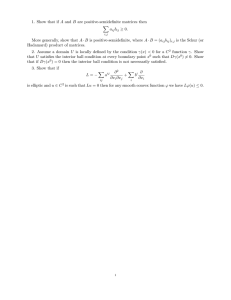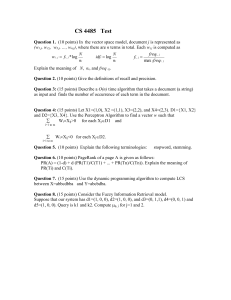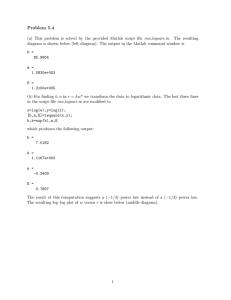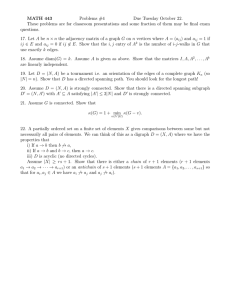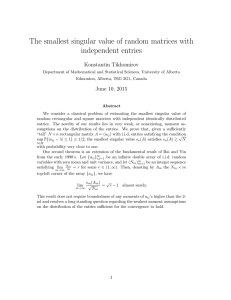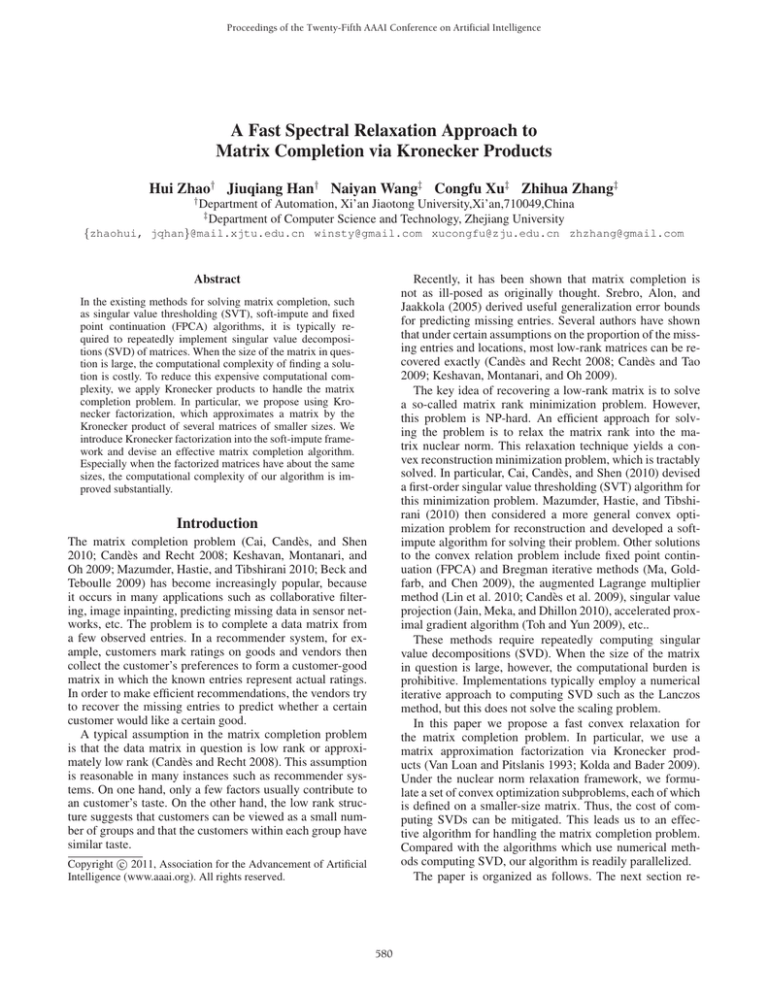
Proceedings of the Twenty-Fifth AAAI Conference on Artificial Intelligence
A Fast Spectral Relaxation Approach to
Matrix Completion via Kronecker Products
Hui Zhao† Jiuqiang Han† Naiyan Wang‡ Congfu Xu‡ Zhihua Zhang‡
†
Department of Automation, Xi’an Jiaotong University,Xi’an,710049,China
‡
Department of Computer Science and Technology, Zhejiang University
{zhaohui, jqhan}@mail.xjtu.edu.cn winsty@gmail.com xucongfu@zju.edu.cn zhzhang@gmail.com
Recently, it has been shown that matrix completion is
not as ill-posed as originally thought. Srebro, Alon, and
Jaakkola (2005) derived useful generalization error bounds
for predicting missing entries. Several authors have shown
that under certain assumptions on the proportion of the missing entries and locations, most low-rank matrices can be recovered exactly (Candès and Recht 2008; Candès and Tao
2009; Keshavan, Montanari, and Oh 2009).
The key idea of recovering a low-rank matrix is to solve
a so-called matrix rank minimization problem. However,
this problem is NP-hard. An efficient approach for solving the problem is to relax the matrix rank into the matrix nuclear norm. This relaxation technique yields a convex reconstruction minimization problem, which is tractably
solved. In particular, Cai, Candès, and Shen (2010) devised
a first-order singular value thresholding (SVT) algorithm for
this minimization problem. Mazumder, Hastie, and Tibshirani (2010) then considered a more general convex optimization problem for reconstruction and developed a softimpute algorithm for solving their problem. Other solutions
to the convex relation problem include fixed point continuation (FPCA) and Bregman iterative methods (Ma, Goldfarb, and Chen 2009), the augmented Lagrange multiplier
method (Lin et al. 2010; Candès et al. 2009), singular value
projection (Jain, Meka, and Dhillon 2010), accelerated proximal gradient algorithm (Toh and Yun 2009), etc..
These methods require repeatedly computing singular
value decompositions (SVD). When the size of the matrix
in question is large, however, the computational burden is
prohibitive. Implementations typically employ a numerical
iterative approach to computing SVD such as the Lanczos
method, but this does not solve the scaling problem.
In this paper we propose a fast convex relaxation for
the matrix completion problem. In particular, we use a
matrix approximation factorization via Kronecker products (Van Loan and Pitslanis 1993; Kolda and Bader 2009).
Under the nuclear norm relaxation framework, we formulate a set of convex optimization subproblems, each of which
is defined on a smaller-size matrix. Thus, the cost of computing SVDs can be mitigated. This leads us to an effective algorithm for handling the matrix completion problem.
Compared with the algorithms which use numerical methods computing SVD, our algorithm is readily parallelized.
The paper is organized as follows. The next section re-
Abstract
In the existing methods for solving matrix completion, such
as singular value thresholding (SVT), soft-impute and fixed
point continuation (FPCA) algorithms, it is typically required to repeatedly implement singular value decompositions (SVD) of matrices. When the size of the matrix in question is large, the computational complexity of finding a solution is costly. To reduce this expensive computational complexity, we apply Kronecker products to handle the matrix
completion problem. In particular, we propose using Kronecker factorization, which approximates a matrix by the
Kronecker product of several matrices of smaller sizes. We
introduce Kronecker factorization into the soft-impute framework and devise an effective matrix completion algorithm.
Especially when the factorized matrices have about the same
sizes, the computational complexity of our algorithm is improved substantially.
Introduction
The matrix completion problem (Cai, Candès, and Shen
2010; Candès and Recht 2008; Keshavan, Montanari, and
Oh 2009; Mazumder, Hastie, and Tibshirani 2010; Beck and
Teboulle 2009) has become increasingly popular, because
it occurs in many applications such as collaborative filtering, image inpainting, predicting missing data in sensor networks, etc. The problem is to complete a data matrix from
a few observed entries. In a recommender system, for example, customers mark ratings on goods and vendors then
collect the customer’s preferences to form a customer-good
matrix in which the known entries represent actual ratings.
In order to make efficient recommendations, the vendors try
to recover the missing entries to predict whether a certain
customer would like a certain good.
A typical assumption in the matrix completion problem
is that the data matrix in question is low rank or approximately low rank (Candès and Recht 2008). This assumption
is reasonable in many instances such as recommender systems. On one hand, only a few factors usually contribute to
an customer’s taste. On the other hand, the low rank structure suggests that customers can be viewed as a small number of groups and that the customers within each group have
similar taste.
c 2011, Association for the Advancement of Artificial
Copyright Intelligence (www.aaai.org). All rights reserved.
580
where AF represents the Frobenius norm of A = [aij ];
that is,
a2ij = tr(AAT ) =
σi2 (A).
A2F =
views recent developments on the matrix completion problem. Our completion method based on the Kronecker factorization of a matrix is then presented, followed by our experimental evaluations. Finally, we give some concluding remarks.
i,j
Problem Formulations
Consider an n×p real matrix X = [xij ] with missing entries,
let Ω ⊂ {1, . . . , n} × {1, . . . , p} denote the indices of observation entries of X, and let Ω̄ = {1, . . . , n} × {1, . . . , p} \ Ω
be the indices of the missing entries. In order to complete the
missing entries, a typical approach is to define an unknown
low-rank matrix Y = [yij ] ∈ Rn×p and to formulate the
following optimization problem
min Y
s.t.
rank(Y)
(i,j)∈Ω (xij
− yij )2 ≤ δ,
Definition 1 (Matrix Shrinkage Operator) Suppose that
the matrix A is an n×p matrix of rank r. Let the condensed
SVD of A be A = UΣVT , where U (n×r) and V (p×r)
satisfy UT U = Ir and VT V = Ir , Σ = diag(σ1 , . . . , σr )
is the r×r diagonal matrix with σ1 ≥ · · · ≥ σr > 0. For
any τ > 0, the matrix shrinkage operator Sτ (·) is defined
by Sτ (A) := UΣτ VT with
(1)
Στ = diag([σ1 −τ ]+ , . . . , [σr −τ ]+ ).
where rank(Y) represents the rank of the matrix Y and δ ≥
0 is a parameter controlling the tolerance in training error.
However, it is not tractable to reconstruct Y from the
rank minimization problem in (1), because it is in general
an NP-hard problem. Since the nuclear norm of Y is the
best convex approximation of the rank function rank(Y)
over the unit ball of matrices, a feasible approach relaxes the
rank minimization into a nuclear norm minimization problem (Candès and Tao 2009; Recht, Fazel, and Parrilo 2007).
Let Y∗ denote the nuclear norm of Y. We have
Y∗ =
r
Here Ir denotes the r × r identity matrix and [t]+ =
max (t, 0).
Recently, using the matrix shrinkage operator, Mazumder,
Hastie, and Tibshirani (2010) devised a so-called soft-impute
algorithm for solving (5). The detailed procedure of the softimpute algorithm is given in Algorithm 1, which computes a
series of solutions to (5) with different step sizes (λ). As we
see, the algorithm requires an SVD computation of an n×p
matrix at every iteration. When both n and p are large, this
is computationally prohibitive.
σi (Y),
i=1
Algorithm 1 The Soft-Impute Algorithm
where r = min{n, p} and the σi (Y) are the singular values
of Y. The nuclear norm minimization problem is defined by
min Z
s.t.
Y∗
(i,j)∈Ω (xij
− yij )2 ≤ δ.
1: Initialize Y (old) = 0, τ > 0, tolerance and create an
ordering set Λ = {λ1 , . . . , λk } in which λi ≥ λi+1 for
any i.
2: for every fixed λ ∈ Λ do
3:
Compute M ← Sτ (Y(old) ).
4:
Compute Y(new) ← PΩ (X) + PΩ̃ (M).
(2)
Clearly, when δ = 0, Problem (2) reduces to
min ||Y||∗
s.t. yij = xij ,
(3)
5:
which has been studied by Cai, Candès, and Shen (2010)
and Candès and Tao (2009). However, Mazumder, Hastie,
and Tibshirani (2010) argued that (3) is too rigid, possibly
resulting in overfitting. In this paper we concentrate on the
case in which δ > 0.
The nuclear norm is an effective convex relaxation of the
rank function. Moreover, off-the-shelf algorithms such as
interior point methods can be used to solve problem (2).
However, they are not efficient if the scale of the matrix in
question is large. Equivalently, we can reformulate (2) in Lagrangian form as follows
1 (xij − yij )2 + γY∗ ,
(4)
min
Y
2
6:
∀(i, j) ∈ Ω,
i
Recently, Cai, Candès, and Shen (2010) proposed a novel
first-order singular value thresholding (SVT) algorithm for
the problem (2). The SVT algorithm is based on a notion of
matrix shrinkage operator.
7:
8:
9:
10:
11:
if
Y (new) −Y (old) F
Y (old) F
< then
Assign Yλ ← Y(new) , Y(old) ← Y(new) and
go to step 2.
else
Assign Y(old) ← Y(new) and go to step 3.
end if
end for
Output the sequence of solutions Yλ1 , . . . , Yλk .
Methodology
Before we present our approach, we give some notation and
definitions. For an n × m matrix A = [aij ], let vec(A) =
(a11 , . . . , an1 , a12 , . . . , anm )T be the nm × 1 vector. In
addition, A⊗B = [aij B] represents the Kronecker product of A and B, and Knm (nm×nm) is the commutation matrix which transforms vec(A) into vec(AT ) (i.e.
Knm vec(A) = vec(AT )). Please refer to (Lütkepohl 1996;
Magnus and Neudecker 1999) for some properties related to
the Kronecker product and the commutation matrix.
(i,j)∈Ω
where γ > 0. Let PΩ (X) be an n×p matrix such that its
(i, j)th entry is xij if (i, j) ∈ Ω and zero otherwise. We
write the problem (4) in matrix form:
1
(5)
min PΩ (X)−PΩ (Y)2F + γY∗ ,
Z
2
581
Assume
= 1, . . . , are ni ×pi matrices where
s that Yi for i
s
n = i=1 ni and p = i=1 pi . We consider the following
relaxation:
s
1
2
(X)
−
P
(Y)
+
γi Yi ∗ , (6)
min
P
Ω
Ω
F
Yi ∈Rni ×pi 2
i=1
In order to use the matrix shrinkage operator, we now have
that the (i, j)th element of Z1 is tr(XTij B), i.e., [Z1 ]ij =
n1 p 1
tr(XTij B), and Z2 =
i=1
j=1 aij Xij . We defer the
derivations of Z1 and Z2 to the appendix.
According to Theorem 1 and Algorithm 1, we immediately have an algorithm for solving the problem in (6),
which is summarized in Algorithm 2. We call it the Kronecker Product-Singular Value Thresholding (KP-SVT). We
now see that at every iteration the algorithm implements the
SVD of two matrices with sizes n1 ×p1 and n2 ×p2 , respectively. Compared with Algorithm 1, the current algorithm
√is
computationally √
effective. In particular, if n1 ≈ n2 ≈ n
and p1 ≈ p2 ≈ p, our algorithm becomes quite effective.
Moreover, we can further speed up the algorithm by setting
s > 2, letting Y = Y1 ⊗Y2 ⊗ · · · ⊗Ys for s > 2.
where Y = Y1 ⊗Y2 ⊗ · · · ⊗Ys . For i = 1, . . . , s, let
Y−i = Y1 ⊗ · · · Yi−1 ⊗Yi+1 ⊗ · · · ⊗Ys ,
which is (n/ni ) × (p/pi ). We now treat Yj for j = i fixed.
Lemma 1 Assume that X is fully observed. If the Yj for
j = i are fixed and nonzero, then
1
h(Yi ) = X − Y2F + γi Yi ∗
2
is strictly convex in Yi .
Theorem 1 Assume that X is fully observed. If the Yj for
j = i are fixed and nonzero, then the minimum of h(Yi ) is
obtained when
Yi = Sγi (Zi ),
where
T T
) ⊗Ini I nn ⊗KTni , p Xi
Zi = vec(Y−i
Algorithm 2 Kronecker Product-Singular Value Thresholding (KP-SVT)
T
1: Initialize Y = PΩ (X), A = 1n1 1T
p1 , B = 1n2 1p2 ,
τ > 0, tolerance , maxStep = k, step = 1.
2: for step < maxStep do
3:
step = step + 1.
T (old)
4:
Compute [A(old) ]ij
←
tr(Yij
B
) and
pi
i
is an ni ×pi matrix. Here Xi is the (np/pi )×pi matrix defined by
vec(Xi ) = vec(Ri XT QTi ),
where Qi = Iαi−1 ⊗Kβs−i ,ni (n×n) with
α0 = β0 = 1, αi =
i
nj , and βi =
j=1
i
A(new) ← S
5:
6:
ζ0 = η0 = 1, ζi =
pj , and ηi =
j=1
7:
i
Xn1 ,2
···
j=1
(new)
if
Y (new) −Y (old) F
Y (old) F
(new)
F
← PΩ (X) + PΩ̄ (A(new) ⊗
< then
In this section we first demonstrate the convergence of the
KP-SVT algorithm through experiments and discuss how
to choose the proper sizes of A and B. Next, we compare
our KP-SVT with the soft-impute algorithm (Mazumder,
Hastie, and Tibshirani 2010) and the conventional SVT algorithm (Cai, Candès, and Shen 2010) both in terms of accuracy and efficiency. All experiments are implemented in
MATLAB and all the reported results are obtained on a desktop computer with a 2.57 GHz CPU and 4 GB of memory.
Both toy data and real world datasets are used. In our simulations, we generate n × p matrices X of rank q by taking
X = UV + noise, where U (n × q) and V (q × p) are independent random matrices with i.i.d. uniform distribution
between 0 and 1, and the noise term is the zero-mean Gaussian white noise. The set of observed entries, Ω, is uniformly
sampled at random over the indices of the matrix. The eval-
Xn1 ,p1
1 1
tr[(Xij − aij B)(Xij − aij B)T ].
2 i=1 j=1
n
Compute Y
).
B
( ||ABnew ||2 ).
Experiments
Using Matlab colon notation, we can write Xij = X((i −
1)n2 + 1 : in2 , (j − 1)p2 + 1 : jp2 ) for i = 1, . . . , n1 ; j =
1, . . . , p1 . Thus,
p1
n1 1
1
2
Xij − aij B2F
φ = X − A ⊗ BF =
2
2 i=1 j=1
=
(old)
τ2
||A(new) ||2
F
Ŷ = Y
8:
.
9:
break.
10:
end if
11: end for
12: Output the solutions Ŷ.
ps+1−j ,
for i = 1, . . . , s.
The proofs of Lemma 1 and Theorem 1 are given in Appendix . The theorem motivates us to employ an iterative
approach to solving the problem in (6).
In the remainder of the paper we consider the special case
of s = 2 for simplicity. Let Y1 = A = [aij ] (n1 ×p1 ) and
Y2 = B = [bij ] (n2 ×p2 ). Moreover, we partition X into
⎡
⎤
X11
X12 · · · X1,p1
X22 · · · X2,p1 ⎥
⎢ X21
X=⎢
, Xij ∈ Rn2 ×p2 .
..
.. ⎥
..
⎣ ...
.
.
. ⎦
Xn1 ,1
( ||BA(old) ||2 ).
n1 Fp1
(new)
← i=1
]ij Yij and
j=1 [A
(new)
j=1
and Ri = Iζi−1 ⊗Kηs−i ,pi (p×p) with
i
Compute B(old)
B(new) ← S
ns+1−j
(old)
τ1
||Bold ||2
F
p1
582
uation criterion is based on the test error as follows:
0.7
Toy
||PΩ̃ (X − Ŷ)||F
.
test error =
||PΩ̃ (X)||F
1
Toy
0.65
2
0.6
We also adopt the Movielens datasets 1 and the Jester joke
dataset 2 to evaluate the performance of the algorithm. The
root mean squared error (RMSE) over the probe set is used
as the evaluation criteria on these datasets. Five datasets are
used in this section, Movielens 100K contains 943 users and
1690 movies with 100,000 ratings (1-5), and Movielens 1M
contains 6,040 users and 4,000 movies with 1 million ratings. Jester joke contains over 1.7 million continuous ratings
(-10.00 to +10.00) of 150 jokes from 63,974 users. Toy1
is a 1000 × 1000 matrix with 20% known entries whose
rank = 10, and Toy2 is a 5000 × 5000 matrix with 10%
known entries whose rank = 20. For real world datasets,
80% ratings are used for training set and 20% ratings are
used for test set.
Test error
0.55
0.5
0.45
0.4
0.35
0.3
0.25
1
2
3
4
5
6
Iterations
7
8
9
10
(a) On toy datasets
1.8
Convergence Analysis
Movielens 100k
Movielens 1M
1.7
We conduct the KP-SVT algorithm on toy datasets and recommendation datasets. Figure 1 depicts the iterative processes of the algorithm on these datasets. From Figure 1,
we see that the algorithm converges after a relatively small
number of iterations.
1.6
RMSE
1.5
1.4
1.3
The Choice of the Sizes of A and B
1.2
The main idea of our KP-SVT algorithm is using A ⊗ B instead of Y to approximate the original matrix X. Following
the property of Kronecker Products, we have n = n1 × n2
and p = p1 ×p2 . If we set n1 = n and p1 = p, our model degenerates to the conventional low-rank approximation problem. Thus, it is very important how to choose the appropriate
values of n1 and p1 .
The main calculation bottleneck of SVT-based low-rank
approximation algorithms lies in the calculation of the SVD
decompositions of n×p matrices, while in KP-SVT we need
only to calculate the SVD decompositions of two sets of
smaller-size matrices. In order to choose an appropriate size,
we make use of the following criterion,
min
s.t.
1.1
1
10
40
60
50
Iterations
70
80
90
100
Figure 1: Convergence analysis of KP-SVT.
The size of the auxiliary matrices A and B is described
in the left of Table 2. First, let’s examine the recovery
performance of these three algorithms. For toy datasets,
SVT obtains a slightly better result while the performance
of our KP-SVT is also acceptable. For real recommendation datasets, unfortunately, SVT does not converge. Note
that here we use the MATLAB implementation of the conventional SVT doanloaded from the second author’s webpage (Cai, Candès, and Shen 2010). Note also that KP-SVT
yields better performance than the soft-impute algorithm on
most datasets. Turning to the computational times, KP-SVT
is generally 5 to 10 times faster than the competitors.
|n1 − n2 | + |p1 − p2 |,
n = n1 × n2 and p = p1 × p2 .
Performance Comparison
In this section, we conduct a set of experiments on five
different datasets to compare the soft-impute (Mazumder,
Hastie, and Tibshirani 2010) algorithm and the conventional
SVT (Cai, Candès, and Shen 2010) algorithm. Especially
for Movielens 1M dataset, we reconfigure the ratio between
training and test set to prove the robustness of KP-SVT.
2
30
(b) On recommendation datasets
From Table 1 we can see that if we set (n1 , p1 ) and (n2 , p2 )
neither too large nor too small, the algorithm runs faster
(sometimes twice as fast) while it at same time obtains better
recovery accuracy.
1
20
Concluding Remarks
In this paper we have proposed a fast spectral relaxation approach to the matrix completion problem by using Kronecker products. In particular, we have devised a
Kronecker-product-based algorithm under the soft-impute
framework (Mazumder, Hastie, and Tibshirani 2010). Our
empirical studies have shown that KP-SVT can substantially
Download from http://www.grouplens.org/node/73
Download from http://eigentaste.berkeley.edu/dataset/
583
Table 1: The choice of the sizes of A and B.
M 100k (943 × 1690)
(n1 , p1 )
(n2 , p2 ) RMSE
(23, 65 )
(41, 26)
1.128
(41, 65)
(23, 26)
1.130
(41, 10) (23, 169) 1.138
(23, 10) (41, 169) 1.152
(41, 169) (23, 10)
1.130
M 1M (6040 × 4000)
(n1 , p1 )
(n2 , p2 )
RMSE
(151, 80)
(40, 50)
1.101
(151, 10)
(40, 400)
1.108
(151, 400)
(40, 10)
1.100
(604, 400)
(10, 10)
1.132
(10, 10)
(604, 400) 1.167
Time
13.8
14.3
14.9
16.0
16.4
Time
169.9
171.7
199.1
385.3
388.1
Table 2: Experimental results of the three algorithms correspond to different training sizes: err− the test error; time− the
corresponding computational time (s), N C− No convergence.
Sizes
SVT
Soft-impute
KP-SVT
Datasets
(n1 , p1 )
(n2 , p2 )
err
time
err
time
err
time
Toy1
(40, 40)
(25, 25)
0.375 21.1
0.381
74.6
0.433
4.7
Toy2
(100, 100) (50, 50)
0.206 237.7
0.522 1051.5
0.281 47.0
M 100K
(23, 65)
(41, 26)
NC
NC
1.229 156.0
1.128 13.8
M 1M 70%
(151, 80) (40, 50)
NC
NC
1.513 305.5
1.114 169.4
M 1M 80%
(151, 80) (40, 50)
NC
NC
1.141 387.9
1.101 169.9
M 1M 90%
(151, 80) (40, 50)
NC
NC
1.382 314.5
1.096 171.8
Jester
(1103, 15) (58, 10)
NC
NC
4.150 271.0
5.094 13.9
reduce computational cost while maintaining high recovery
accuracy. The approach can also be applied to speed up other
matrix completion methods which are based on SVD, such
as FPCA (Ma, Goldfarb, and Chen 2009).
Although we have illustrated especially two-matrix products in this paper, Kronecker products can be applied recursively when the size of the matrix in question is large.
Another possible proposal is to consider the following optimization problem
Using some matric algebraic calculations, we further have
T
T
T
j=i
T T
= −vec(Xi ) [(I
+(
j=i
n
ni
⊗Kn
2
p
i, p
i
where the Ai and Bi have appropriate sizes and Y =
s
i=1 Ai ⊗Bi . We will address matrix completion problems
using this proposal in future work.
+(
j=i
T
T
)(vec(Y−i )⊗Ini ) ⊗ Ipi ]vec(dYi )
T
Yj F )tr(Yi dYi )
T T
= −tr (vec(Y−i ) ⊗Ini )(I
s
s
1
γ1i Ai ∗ +
γ2i Bi ∗ ,
min PΩ (X)−PΩ (Y)2F +
Ai ,Bi 2
i=1
i=1
2
n
ni
T
⊗Kn
p
i, p
i
T
)Xi dYi
T
Yj F )tr(Yi dYi )
T
= −tr(Zi dYi ) + (
j=i
2
T
Yj F )tr(Yi dYi ).
Here we use the fact that if A and B are m×n and p×q
matrices, then
vec(A ⊗ B) = [((In ⊗ Kqm )(vec(A) ⊗ Iq )) ⊗ Ip ]vec(B).
The Proofs of Lemma 1 and Theorem 1
2
φ
=
Accordingly, we conclude that ∂vec(YT∂)∂vec(Y
T)
( j=i Yj 2F )In1 pi . Thus, h(Yi ) is strictly convex in Yi .
We now obtain that Ŷi minimizes h if and only if 0 is a
subgradient of the function h at the point Ŷi ; that is,
1
γi
Zi + 0 ∈ Ŷi − 2
2 ∂Ŷi ∗ ,
j=i Yj F
j=i Yj F
Consider that Ri X
is p×n. We are always able to define an (np/pi )×pi matrix Xi such that
T
T T
dφ = −vec(Ri X Qi ) vec(Y−i ⊗ dYi )
2
T
+(
Yj F )tr(Yi dYi )
QTi
vec(XTi ) = vec(Ri XT QTi ).
Note that Qi QTi = In , Ri Ri = Ip and Qi (Y1 ⊗ · · · ⊗
Ys )RTi = Y−i ⊗ Yi . Let φ = 12 X − Y2F We have
dφ = −tr (X−Y)(Y1T ⊗ · · · ⊗ dYiT ⊗ · · · ⊗ YsT )
T
⊗ YiT )Qi
= −tr (X−Y)RTi (Y−i
where ∂Ŷi ∗ is the set of subgradients of the nuclear norm.
We now consider the special case that s = 2. In this case,
we let Y1 = A = [aij ] (n1 ×p1 ) and Y2 = B = [bij ]
(n2 ×p2 ). Moreover, we partition X into
⎡
⎤
X11
X12 · · · X1,p1
X22 · · · X2,p1 ⎥
⎢ X21
X=⎢
, Xij ∈ Rn2 ×p2 .
..
.. ⎥
..
⎣ ...
⎦
.
.
.
Xn1 ,1 Xn1 ,2 · · · Xn1 ,p1
T
⊗ dYiT ))
= −tr(Qi XRTi (Y−i
T
+ tr(Qi YRTi (Y−i
⊗ dYiT ))
T
⊗ dYiT ))
= −tr(Qi XRTi (Y−i
T
T
+ tr((Y−i
Y−i
) ⊗ (Yi dYiT ))
584
Using MATLAB colon notation, we can write Xij =
X((i − 1)n2 + 1 : in2 , (j − 1)p2 + 1 : jp2 ) for i =
1, . . . , n1 ; j = 1, . . . , p1 . Thus,
p1
n1 1
1
Xij − aij B2F
φ = X − A ⊗ B2F =
2
2 i=1 j=1
Lütkepohl, H. 1996. Handbook of Matrices. New York:
John Wiley & Sons.
Ma, S.; Goldfarb, D.; and Chen, L. 2009. Fixed point and
Bregman iterative methods for matrix rank minimization.
Mathematical Programming Series A.
Magnus, J. R., and Neudecker, H. 1999. Matrix Calculus
with Applications in Statistics and Econometric. New York:
John Wiley & Sons, revised edition edition.
Mazumder, R.; Hastie, T.; and Tibshirani, R. 2010. Spectral regularization algorithms for learning large incomplete
matrices. Journal of machine learning research 11(2):2287–
2322.
Recht, B.; Fazel, M.; and Parrilo, P. A. 2007. Guaranteed
minimum-rank solutions of linear matrix equations via nuclear norm minimization. SIAM Review 52(3):471–501.
Srebro, N.; Alon, N.; and Jaakkola, T. 2005. Generalization
error bounds for collaborative prediction with low-rank matrices. Advances in Neural Information Processing Systems.
Toh, K., and Yun, S. 2009. An accelerated proximal gradient algorithm for nuclear norm regularized least squares
problems.
Van Loan, C. F., and Pitslanis, N. 1993. Approximation
with kronecker products. In Moonen, M. S.; Golub, G. H.;
and de Moor, B. L. R., eds., Linear Algebra for Large Scale
and Real-Time Applications. Dordrecht: Kluwer Academic
Publisher. 293–314.
1 1
=
tr[(Xij − aij B)(Xij − aij B)T ].
2 i=1 j=1
n
p1
We have
dφ = −
p1
n1 tr[B(Xij − aij B)T ]daij
i=1 j=1
−
p1
n1 aij tr[(Xij − aij B)dBT ].
i=1 j=1
It then follows that
∂φ ∂φ
= −Z1 + tr(BBT )A,
=
∂A
∂aij
where the (i, j)the element of Z1 is tr(XTij B), i.e., [Z1 ]ij =
tr(XTij B), and that
∂φ
= −Z2 + tr(AAT )B
∂A
n1 p 1
where Z2 = i=1
j=1 aij Xij .
References
Beck, A., and Teboulle, M. 2009. A fast iterative shrinkagethresholding alghrithm for linear inverse problems. SIAM
Journal on Imaging Sciences 183–202.
Cai, J.; Candès, E. J.; and Shen, Z. 2010. A singular value
thresholding algorithm for matrix completion. SIAM Journal on Optimization 20:1956–1982.
Candès, E. J., and Recht, B. 2008. Exact matrix completion
via convex optimization. Found. of Comput. Math. 9:717–
772.
Candès, E. J., and Tao, T. 2009. The power of convex relaxation: Near-optimal matrix completion. IEEE Trans. Inform.
Theory (to appear).
Candès, E. J.; Li, X.; Ma, Y.; and Wright, J. 2009. Robust
principal component analysis. Microsoft Research Asia, Beijing, China.
Jain, P.; Meka, R.; and Dhillon, I. 2010. Guaranteed rank
minimization via singular value projection. In Neural Information Processing Systems(NIPS)24.
Keshavan, R.; Montanari, A.; and Oh, S. 2009. Matrix completion from a few entries. In Proceedings of International
Symposium on Information Theory (ISIT 2009).
Kolda, T. G., and Bader, B. W. 2009. Tensor decompositions
and applications. SIAM Review 51(3):455–500.
Lin, Z.; Chen, M.; Wu, L.; and Ma, Y. 2010. The augmented
lagrange multiplier method for exact recovery of corrupted
low-rank matrices. Technical report, Electrical & Computer
Engineering Department, University of Illinois at UrbanaChampaign, USA.
585

